Verlinden 120mm Napoleon 'Field Commander'
|
KIT #: |
1678 |
|
PRICE: |
$27.00 SRP |
|
DECALS: |
N/A |
|
REVIEWER: |
Blair Stewart |
|
NOTES: |
Resin figure |
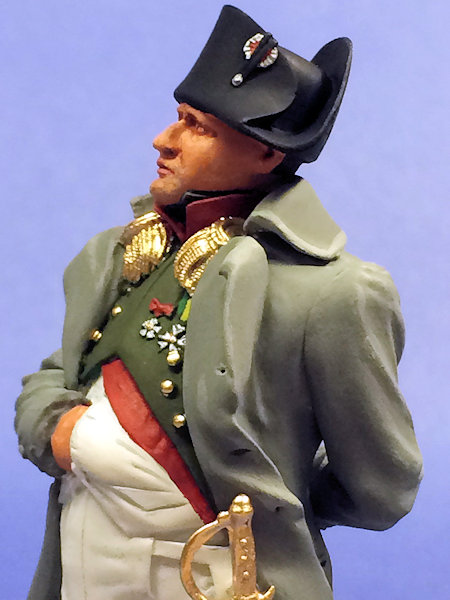 Considered
one of the world’s greatest military leaders, Napoleon Bonaparte (1769-1821),
also known as Napoleon I, was a French military leader and emperor who conquered
much of Europe in the early 19th century. Born on the island of Corsica,
Napoleon rapidly rose through the ranks of the military during the French
Revolution (1789-1799).
Considered
one of the world’s greatest military leaders, Napoleon Bonaparte (1769-1821),
also known as Napoleon I, was a French military leader and emperor who conquered
much of Europe in the early 19th century. Born on the island of Corsica,
Napoleon rapidly rose through the ranks of the military during the French
Revolution (1789-1799).
In 1786 as a
young artillery lieutenant, Napoleon returned to Corsica. There Napoleon sided
with the Corsican resistance to the French occupation, but after a falling out
with the resistance leadership, Napoleon and his family relocated to France in
1793, where they assumed the French version of their name: Bonaparte. For
Napoleon, his return to France meant a return to service with the French
military.
All of this
turmoil created opportunities for ambitious military leaders such as Napoleon.
In 1795, Napoleon came into the good graces of the Directory – a group of five
men who held the executive power in France according to the constitution of the
French Revolution - after he saved the government from counter-revolutionary
forces. For his efforts, the Directory named Napoleon commander of the Army of
the Interior. In addition, he was a trusted advisor to the Directory on military
matters.
In 1796,
Napoleon, at the age of 28, took command of the Army of Italy, a post he had
coveted. The army, just 30,000 strong, disgruntled and underfed, was soon turned
around by the young commander. Under his direction the rebuilt army won numerous
crucial victories against the Austrians, which greatly expanded the French
empire and helped make Napoleon the French military's brightest star.
After
squashing an internal threat by the royalists, who wished to return France to a
monarchy, Napoleon was on the move again, this time to the Middle East to
counter Great Britain's empire by occupying Egypt and disrupting English trade
routes to India.
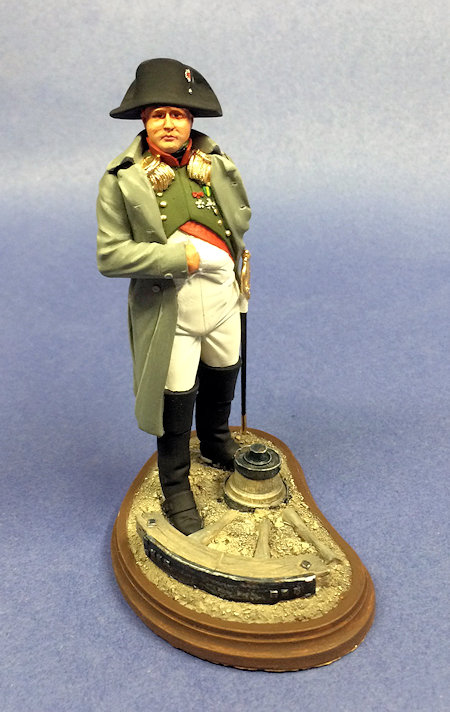 But his
military campaign proved disastrous. On August 1, 1798, Admiral Horatio Nelson's
fleet decimated his forces in the Battle of the Nile. Napoleon's image was
damaged by the loss, and in a show of newfound confidence against the commander,
Britain, Austria, Russia and Turkey formed a new coalition against France. In
the spring of 1799, the coalition defeated the French armies in Italy, forcing
France to give up much of the peninsula.
But his
military campaign proved disastrous. On August 1, 1798, Admiral Horatio Nelson's
fleet decimated his forces in the Battle of the Nile. Napoleon's image was
damaged by the loss, and in a show of newfound confidence against the commander,
Britain, Austria, Russia and Turkey formed a new coalition against France. In
the spring of 1799, the coalition defeated the French armies in Italy, forcing
France to give up much of the peninsula.
After
returning from Egypt, Napoleon engineered a coup in November 1799 and became
First Consul of the Republic. Another victory over the Austrians at the Battle
of Marengo in 1800 secured his political power. With the Concordat of 1801,
Napoleon restored the religious privileges of the Catholic Church while keeping
the lands seized by the Revolution. The state continued to nominate the bishops
and to control church finances. He extended his political control over France
until the Senate declared him Emperor of the French in 1804, launching the
French Empire. But unresolvable differences with the British meant that the
French were facing a Third Coalition by 1805. Napoleon shattered this coalition
with decisive victories in the Ulm Campaign and a historic triumph at the Battle
of Austerlitz, which led to the elimination of the Holy Roman Empire.
Many
military historians consider The Battle of Austerlitz as one of Napoleon’s
greatest victories. His 68,000 troops defeated almost 90,000 Russians and
Austrians under General M.I. Kutuzov, forcing Austria to make peace with France
and keeping Prussia temporarily out of the anti-French alliance.
The battle
took place near Austerlitz in Moravia after the French had entered Vienna on
November 13 and then pursued the Russian and Austrian allied armies into
Moravia. The arrival of the Russian emperor Alexander I virtually deprived
Kutuzov of supreme control of his troops. The allies decided to fight Napoleon
west of Austerlitz and occupied the Pratzen Plateau, which Napoleon had
deliberately evacuated to create a trap. The allies then launched their main
attack, with 40,000 men, against the French right (south) to cut them off from
Vienna. While Marshal Louis Davout’s corps of 10,500 men stubbornly resisted
this attack, and the allied secondary attack on Napoleon’s northern flank was
repulsed, Napoleon launched Marshal Nicolas Soult, with 20,000 infantry troops,
up the slopes to smash the weak allied center on the Pratzen Plateau. Soult
captured the plateau and, with 25,000 reinforcements from Napoleon’s reserve,
held it against the allied attempts to retake it. The allies were soon split in
two, and Napoleon’s army vigorously attacked and pursued them both north and
south of the plateau. The allies lost 15,000 men killed and wounded and 11,000
captured, while Napoleon lost 9,000 men. The remnants of the allied army were
scattered.
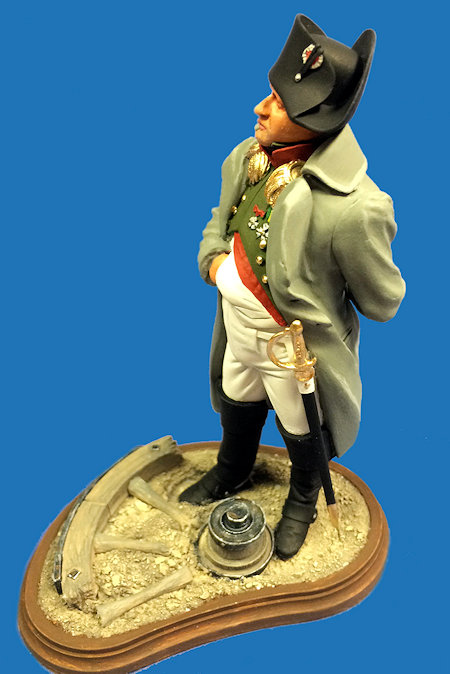 Two days
later Francis I of Austria agreed to a suspension of hostilities and arranged
for Alexander I to take his army back to Russia. In October 1805, however, the
British fleet, again under Admiral Nelson, destroyed the Franco-Spanish fleet at
the Battle of Trafalgar, allowing Britain to impose a naval blockade on the
French coasts. In retaliation, Napoleon established the Continental System in
1806 to cut off continental trade with Britain. The Fourth Coalition took up
arms against him the same year because Prussia became worried about growing
French influence on the continent. After quickly knocking out Prussia at the
battles of Jena and Auerstedt, Napoleon turned his attention towards the
Russians and soundly defeated them in June 1807 at Friedland, which forced the
Russians to accept the Treaties of Tilsit.
Two days
later Francis I of Austria agreed to a suspension of hostilities and arranged
for Alexander I to take his army back to Russia. In October 1805, however, the
British fleet, again under Admiral Nelson, destroyed the Franco-Spanish fleet at
the Battle of Trafalgar, allowing Britain to impose a naval blockade on the
French coasts. In retaliation, Napoleon established the Continental System in
1806 to cut off continental trade with Britain. The Fourth Coalition took up
arms against him the same year because Prussia became worried about growing
French influence on the continent. After quickly knocking out Prussia at the
battles of Jena and Auerstedt, Napoleon turned his attention towards the
Russians and soundly defeated them in June 1807 at Friedland, which forced the
Russians to accept the Treaties of Tilsit.
Hoping to
extend his Continental System, Napoleon invaded Iberia and declared his brother
Joseph the King of Spain in 1808. The Spanish and the Portuguese revolted with
British support. The Peninsular War, noted for its brutal guerrilla warfare,
lasted six years and culminated in an Allied victory. Fighting also erupted in
Central Europe, as the Austrians launched another attack against the French in
1809. Napoleon defeated them at the Battle of Wagram, dissolving the Fifth
Coalition formed against France. By 1811, Napoleon ruled over 70 million people
across an empire that had domination in Europe, which had not witnessed this
level of political consolidation since the days of the Roman Empire. He
maintained his strategic status through a series of alliances and family
appointments. He created a new aristocracy in France while allowing the return
of nobles who had been forced into exile by the Revolution.
Tensions
over rising Polish nationalism and the economic effects of the Continental
System led to renewed confrontation with Russia. To enforce his blockade,
Napoleon launched an invasion of Russia in the summer of 1812. The resulting
campaign witnessed the catastrophic collapse of the Grand Army (as a similar
invasion of Russia in 1940 by the Germans would similarly impact the Wehrmact),
forcing the French to retreat, as well as leading to the widespread destruction
of Russian lands and cities.
In 1813,
Prussia and Austria joined Russian forces in a Sixth Coalition against France. A
chaotic military campaign in Central Europe eventually culminated in a large
Allied army defeating Napoleon at the Battle of Leipzig in October. The next
year, the Allies invaded France and captured Paris, forcing Napoleon to abdicate
in April 1814. He was exiled to the island of Elba. The Bourbons were restored
to power and the French lost most of the territories that they had conquered
since the Revolution.
Napoleon
escaped from Elba in February 1815 and took control of the government once
again. The Allies formed a Seventh Coalition, and Allied forces under command of
the Duke of Wellington defeated Napoleon at the Battle of Waterloo in June.
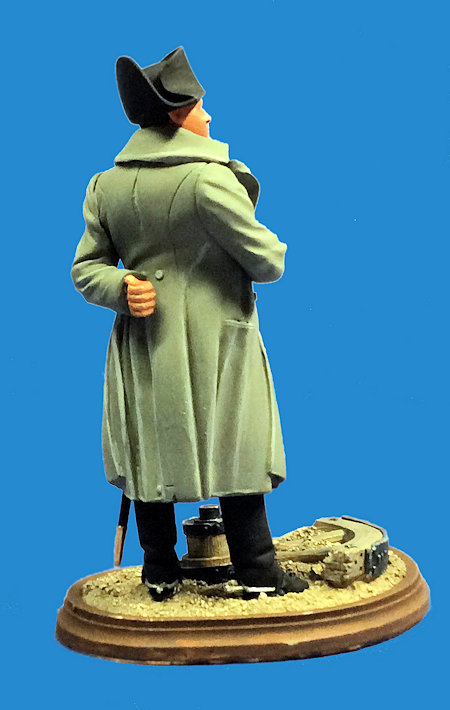 While much
has been written about Napoleon’s defeat at Waterloo, David Chandler in his
voluminous work “The Campaigns of Napoleon” cites these major causes:
While much
has been written about Napoleon’s defeat at Waterloo, David Chandler in his
voluminous work “The Campaigns of Napoleon” cites these major causes:
-
Napoleon
had grown obstinate, arrogant and overconfident.
-
He
appointed second-rate men to keep posts, even though better men were
available to him, and relied instead on the “magic of his own reputation” to
make up for their deficiencies in battle.
-
He
underestimated the courage and staying power of his opponents.
-
He
ignored the Austrian commander Blucher’s sense of loyalty and discounted
Wellington’s ability as a general.
According to
Chandler, these errors led Napoleon to delay the opening of the battle on June
18 and then to refuse to reinforce Marshall Ney at the critical moment in the
battle. In addition, throughout the battle, Napoleon apparently failed to
control his major subordinates, thereby robbing them of his overall supervision
to execute the master battle plan in a timely manner and with a minimum of
confusion.
After the
Battle of Waterloo, the British captured Napoleon and imprisoned him on the
remote island of Saint Helena. He died in 1821 at the age of 51. In 1840, a
million people witnessed his remains returning to Paris, where they still reside
at Les Invalides.
The figure
is another finely detailed 120mm cast resin military figure by Verlinden
Productions. When completed, the figure strikes an interesting pose as a
commander surveying the battlefield.
As is
typical of these figures, the kit comes in 14 separate cast resin parts with
some of them attached to
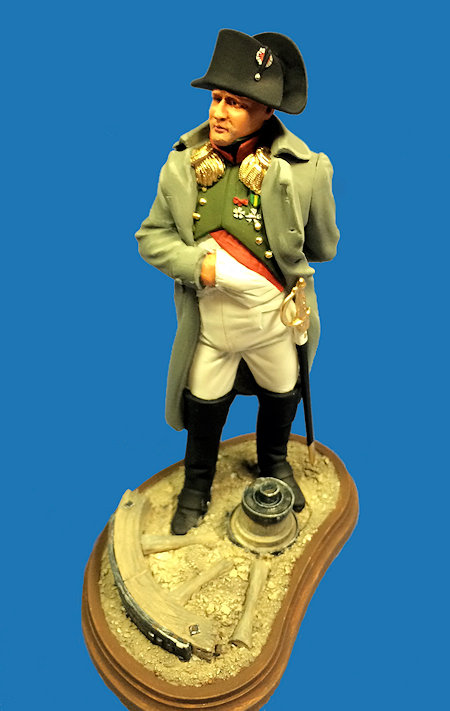 resin casting blocks. The arms, torso and legs are
separate components, as are the figure’s saber, riding spurs and hat. As usual,
the sculpting of the figure is extremely sharp with the great detail afforded by
the large 120mm scale.
resin casting blocks. The arms, torso and legs are
separate components, as are the figure’s saber, riding spurs and hat. As usual,
the sculpting of the figure is extremely sharp with the great detail afforded by
the large 120mm scale.
Another plus
is the base, which includes battlefield “debris” represented by a broken cannon
wheel.
As usual
with these figures, my first step was to remove the various pieces from their
casting blocks and then clean them up. For the larger pieces, I use a razor saw
to cut the piece off the resin block, and then use a sharp Xacto knife to clean
things up (a note for you younger modelers: DO NOT do as I do; i.e., carve
toward you with an xacto knife. Not only is it inevitable that you will cut
yourself, but you will feel especially foolish when you do so. Needless to say,
in my old age I am getting pretty good at “suturing” self-inflicted knife wounds
using Super Glue and a variety of other clamps/tourniquets to stop the
bleeding).
One can also
use a piece of sandpaper on a flat surface to remove the final casting block
resin (also exercise caution here if you use this method: it’s easy to get
carried away with the sanding and sand away more material than you want). Once I
did this, I used Super Glue to assemble the torso, legs, arms and hands.
I started by spray-painting the figure
with Testors flat white enamel to serve as the base coat and provide a light
base for subsequent hand painting.
The next
step was to hand paint the figure. I began with the head and hands. For these
parts I used Testors flat flesh enamel. As always, with figures, a major
challenge is the skin tones, and then the proper shading to get some kind of
expression on the face. I mixed some Testors flat white with the flesh paint and
highlighted raised portions of the figure’s face and hands. later detailing of
the face with lighter shades of flesh tones.. I then painted the figure’s hair
with acrylic burnt umber.
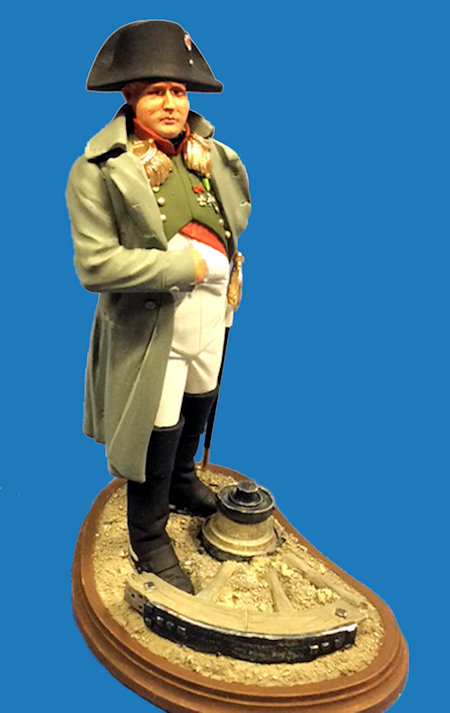 One of the
most difficult things to do on a figure is to paint the eyes. For figures that
are in an action pose, one can generally get by with a “squinting” look that
does not require a painted eyeball. But this figure clearly has open eyes,
although they are somewhat “squinted”. I used Testors flat white to paint in
oblong eyeballs, then some acrylic black to represent the irises. The key to
achieving realistic eyes is to then paint a bottom and top lid over the white
eyeball so that the figure doesn’t have that “bug-eyed” look. For those of you
who are deterred from figure painting by this aspect, trust me: it takes
practice and more practice. I personally am not there yet, but I can see
positive progress with each figure I complete.
One of the
most difficult things to do on a figure is to paint the eyes. For figures that
are in an action pose, one can generally get by with a “squinting” look that
does not require a painted eyeball. But this figure clearly has open eyes,
although they are somewhat “squinted”. I used Testors flat white to paint in
oblong eyeballs, then some acrylic black to represent the irises. The key to
achieving realistic eyes is to then paint a bottom and top lid over the white
eyeball so that the figure doesn’t have that “bug-eyed” look. For those of you
who are deterred from figure painting by this aspect, trust me: it takes
practice and more practice. I personally am not there yet, but I can see
positive progress with each figure I complete.
For most of
the other parts of the figure, I primarily used relatively inexpensive flat
acrylic paints. Another figure painting challenge is finding the right “tint” of
colors for uniforms and other items. This just takes experimentation of mixing
and remixing colors until achieving the right tint. For the
riding boots and the bicorn hat, I used black acrylic, and then picked out the
emblem on the hat with Testors silver and acrylic red. For the
uniform buttons, saber tips and handle, epaulets and uniform decorations, I used
Testors gold enamel.
To finish my
figure, I painted the base with acrylic tan, and then used a black wash to bring
out the definition of the soil, sand and rocks. I painted the cannon wheel with
a darkened tan and then dry brushed the wood grain with a light gray to give it
a weathered look. I painted the metal parts with Testors Gunmetal and then
highlighted the edges of the metal parts with a Prismacolor metallic silver
pencil. Finally, I painted the bottom of the base with acrylic burnt umber to
simulate wood.
This is
another outstanding Verlinden figure, and the base really highlights it. When it
is completed, the figure presents a great likeness of Napoleon. If you are into
military or other figures, I highly recommend this kit.
-
Napoleon
Biography, Biography.com, February 2016.
-
Napoleon, Wikipedia,
February 2016.
-
David
Chandler, “The Campaigns of Napoleon: The Mind and Method of History’s
Greatest Soldier,” Macmillan Company, New York, NY, 1966.
-
Battle of Austerlitz, Brittannica.com, February 2016.
-
“Summaries
of Selected Military Campaigns,” Department of Military Art and Engineering,
US Military Academy, West Point, NY, 1960.
Blair Stewart
February 2016
Copyright ModelingMadness.com
If you would like your product reviewed fairly and fairly quickly, please
contact
the editor or see other details in the
Note to
Contributors.
Back to the Main Page
Back to the Review
Index Page
 Considered
one of the world’s greatest military leaders, Napoleon Bonaparte (1769-1821),
also known as Napoleon I, was a French military leader and emperor who conquered
much of Europe in the early 19th century. Born on the island of Corsica,
Napoleon rapidly rose through the ranks of the military during the French
Revolution (1789-1799).
Considered
one of the world’s greatest military leaders, Napoleon Bonaparte (1769-1821),
also known as Napoleon I, was a French military leader and emperor who conquered
much of Europe in the early 19th century. Born on the island of Corsica,
Napoleon rapidly rose through the ranks of the military during the French
Revolution (1789-1799).  But his
military campaign proved disastrous. On August 1, 1798, Admiral Horatio Nelson's
fleet decimated his forces in the Battle of the Nile. Napoleon's image was
damaged by the loss, and in a show of newfound confidence against the commander,
Britain, Austria, Russia and Turkey formed a new coalition against France. In
the spring of 1799, the coalition defeated the French armies in Italy, forcing
France to give up much of the peninsula.
But his
military campaign proved disastrous. On August 1, 1798, Admiral Horatio Nelson's
fleet decimated his forces in the Battle of the Nile. Napoleon's image was
damaged by the loss, and in a show of newfound confidence against the commander,
Britain, Austria, Russia and Turkey formed a new coalition against France. In
the spring of 1799, the coalition defeated the French armies in Italy, forcing
France to give up much of the peninsula. Two days
later Francis I of Austria agreed to a suspension of hostilities and arranged
for Alexander I to take his army back to Russia. In October 1805, however, the
British fleet, again under Admiral Nelson, destroyed the Franco-Spanish fleet at
the Battle of Trafalgar, allowing Britain to impose a naval blockade on the
French coasts. In retaliation, Napoleon established the Continental System in
1806 to cut off continental trade with Britain. The Fourth Coalition took up
arms against him the same year because Prussia became worried about growing
French influence on the continent. After quickly knocking out Prussia at the
battles of Jena and Auerstedt, Napoleon turned his attention towards the
Russians and soundly defeated them in June 1807 at Friedland, which forced the
Russians to accept the Treaties of Tilsit.
Two days
later Francis I of Austria agreed to a suspension of hostilities and arranged
for Alexander I to take his army back to Russia. In October 1805, however, the
British fleet, again under Admiral Nelson, destroyed the Franco-Spanish fleet at
the Battle of Trafalgar, allowing Britain to impose a naval blockade on the
French coasts. In retaliation, Napoleon established the Continental System in
1806 to cut off continental trade with Britain. The Fourth Coalition took up
arms against him the same year because Prussia became worried about growing
French influence on the continent. After quickly knocking out Prussia at the
battles of Jena and Auerstedt, Napoleon turned his attention towards the
Russians and soundly defeated them in June 1807 at Friedland, which forced the
Russians to accept the Treaties of Tilsit. While much
has been written about Napoleon’s defeat at Waterloo, David Chandler in his
voluminous work “The Campaigns of Napoleon” cites these major causes:
While much
has been written about Napoleon’s defeat at Waterloo, David Chandler in his
voluminous work “The Campaigns of Napoleon” cites these major causes: resin casting blocks. The arms, torso and legs are
separate components, as are the figure’s saber, riding spurs and hat. As usual,
the sculpting of the figure is extremely sharp with the great detail afforded by
the large 120mm scale.
resin casting blocks. The arms, torso and legs are
separate components, as are the figure’s saber, riding spurs and hat. As usual,
the sculpting of the figure is extremely sharp with the great detail afforded by
the large 120mm scale.  One of the
most difficult things to do on a figure is to paint the eyes. For figures that
are in an action pose, one can generally get by with a “squinting” look that
does not require a painted eyeball. But this figure clearly has open eyes,
although they are somewhat “squinted”. I used Testors flat white to paint in
oblong eyeballs, then some acrylic black to represent the irises. The key to
achieving realistic eyes is to then paint a bottom and top lid over the white
eyeball so that the figure doesn’t have that “bug-eyed” look. For those of you
who are deterred from figure painting by this aspect, trust me: it takes
practice and more practice. I personally am not there yet, but I can see
positive progress with each figure I complete.
One of the
most difficult things to do on a figure is to paint the eyes. For figures that
are in an action pose, one can generally get by with a “squinting” look that
does not require a painted eyeball. But this figure clearly has open eyes,
although they are somewhat “squinted”. I used Testors flat white to paint in
oblong eyeballs, then some acrylic black to represent the irises. The key to
achieving realistic eyes is to then paint a bottom and top lid over the white
eyeball so that the figure doesn’t have that “bug-eyed” look. For those of you
who are deterred from figure painting by this aspect, trust me: it takes
practice and more practice. I personally am not there yet, but I can see
positive progress with each figure I complete.